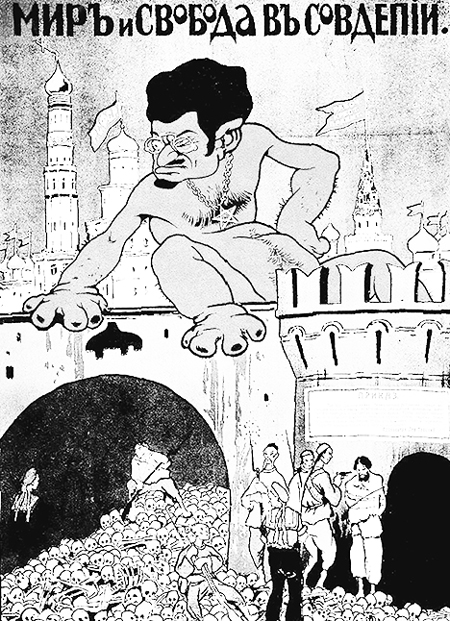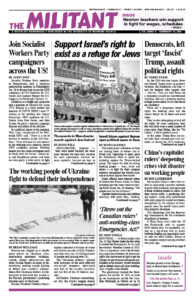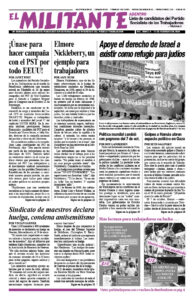
“The Council of People’s Commissars declares that the anti-Semitic movement and pogroms against Jews are fatal to the interests of the workers’ and peasants’ revolution,” said V.I. Lenin, the central leader of the Bolshevik Party and the 1917 Russian Revolution, in a government declaration after workers conquered power.
It instructed “all Soviet deputies to take uncompromising measures to tear the anti-Semitic movement out by the roots.”
The Bolsheviks meant what they said.
They put an end to the pogroms and persecution against Jews that had been widespread under the dictatorial rule of the czars. Russia was home to the world’s largest Jewish population. Gramophone recordings of Lenin’s speeches against Jew-hatred were sent all across the country to spread the message.
The revolutionary government integrated Jews into all aspects of social and political life, and Jewish culture flourished in the 1920s. They took part in the mighty battles to defend the revolution against the reactionary armies of the former landowners and capitalists along with the invading armies of 14 imperialist powers. In the midst of this struggle the Red Army put an end to pogroms these forces carried out.
These blows to Jew-hatred and advances in the lives of the Jews were reversed a few years later, part of a thoroughgoing counterrevolution against Lenin’s program and policies carried out by privileged layers in the state bureaucracy headed by Joseph Stalin.
The Stalinist regime sought to drive working people out of political life, murdered the leaders of the 1917 revolution and reimposed the czarist prison house of nations across Russia. An inevitable consequence was the resurrection of Jew-hatred. The Stalinist reign of terror was wielded with special vengeance against Leon Trotsky and other defenders of Lenin’s revolutionary course. Stalin used appeals to Jew-hatred to target any who questioned his power.
When Bolshevik leaders Lev Kamenev and Grigory Zinoviev united with Trotsky to oppose the Stalinist regime in 1927, the regime’s use of antisemitism accelerated. All three were Jewish. “Jews, even when unreservedly devoted to the general line [of Stalin] were removed from responsible party and Soviet posts,” Trotsky wrote. In Moscow’s factories, “agitators spoke brazenly: ‘The Jews are rioting.’”
“The country of the great proletarian revolution is now passing through a period of profound reaction,” Trotsky pointed out in a 1937 interview. Stalin seeks “to direct especially against the Jews the existing discontent against the bureaucracy.”
Show trials against Stalin’s opponents in the 1930s were “staged with the hardly concealed design of presenting internationalists as faithless and lawless Jews who are capable of selling themselves to the Gestapo,” Trotsky said.
This included Trotsky’s son, Sergei Sedov, accused of plotting the mass poisoning of workers, echoing czarist slanders that Jews poisoned wells and spread plagues.
During World War II, when the Nazi army was driven out of western parts of the Soviet Union, Stalin refused to reopen Jewish schools and cultural institutions that the Nazis had shut down. He refused to allow a monument to the over 33,000 Jews the Nazis slaughtered in 1941 at Babyn Yar in Ukraine.
Jews attacked after Golda Meir visit
Even though the Soviet Union officially backed the creation of the state of Israel, Stalin launched a new wave of antisemitic attacks in 1948. Some 50,000 Soviet Jews took to the streets of Moscow to greet Golda Meir, Israel’s first ambassador to the Soviet Union. Stalin’s response was to shut down the Yiddish language paper Einikeit and Jewish publishing house Emess.
The Jewish Anti-Fascist Committee, established by Stalin during the war to win support among Jews worldwide for the defense of the Soviet Union, was dismantled. Its leaders were accused of being “rootless cosmopolitans” and executed.
The following year, leaders of the ruling Communist parties in Hungary and Czechoslovakia were targeted in purge trials, as Stalin moved to consolidate Moscow’s control in Eastern Europe.
In Czechoslovakia in 1951 workers held strikes to protest government calls for higher productivity to fulfill Moscow’s incessant demands for more goods. In response, Stalin orchestrated the arrest of Rudolf Slansky and 14 other central leaders of the Communist Party. Eleven were Jews. Where their names were not obviously Jewish the indictment added their original Jewish names. All were accused of being “Trotskyite-Titoist-Zionist” traitors and agents of the Israeli government.
Stalin’s use of Jew-hatred to protect his rule reached a crescendo with the 1953 Doctors Plot. Nine doctors, six of them Jews, were accused of conspiring to “wipe out the leading cadres of the Soviet Union.”
Tens of thousands of Jews were thrown out of their jobs. The secret police prepared for the mass expulsion of Jews from cities. In Kazakhstan barracks were erected to detain them. Then Stalin died and his successors backed off.
The 1952 edition of the Soviet Encyclopedia announced, “‘The Jewish question’ does not exist in the U.S.S.R.” Defenders of Stalinism like Paul Robeson, who watched silently as the regime killed friends of his who had led the Jewish Anti-Fascist Committee, said the same.
The Soviet government’s use of Jew-hatred didn’t end with Stalin’s death in 1953. Demands raised in 1968 for the Stalinist regimes in Poland and Czechoslovakia to grant political rights were denounced as “Zionist.”
Following the collapse of the USSR in 1991, Russia emerged as a capitalist state and Vladimir Putin fought his way to the presidency. In a 2021 speech he said Ukraine is nothing more than a part of Russia, citing a 1648 Cossack revolt that drove the Polish monarchy out of Ukraine. He failed to mention that those Cossacks also led the slaughter of 100,000 Jews.
Putin also uses antisemitic attacks to target Ukrainian President Volodymyr Zelensky. “The Western masters,” he said in September, “put a person at the head of Ukraine who is an ethnic Jew, with Jewish roots, with Jewish origins,” to cover up what Putin claims is Ukraine’s “glorification of Nazism.”
The fight today to end Jew-hatred once and for all in Russia and worldwide begins with building parties to emulate the course led by Lenin and the Bolsheviks.

